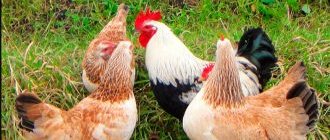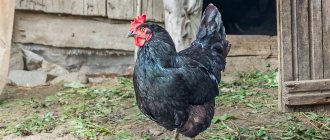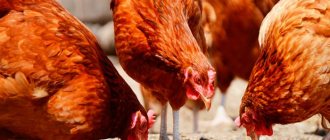Unique barbezier chickens were selected several centuries ago in France. Their homeland is the town of Barbezier, thanks to which they got their beautiful name. At one time, this egg-meat breed was on the verge of extinction. It received a second life only at the end of the 19th century, when a group of French breeders began to restore it. The reason why these chickens are once again in demand is the unique taste of their meat, similar to game. Now barbezier is bred in many countries around the world.
Origin of the Barbezier chicken
The Barbeusieux is an ancient native breed originally from France. Its place of origin is the Poitou-Charentes region, the city of Barbezieux. A striking natural feature of the province is clay soils and high humidity. Previously, farmers did not pay attention to the living conditions of chickens in their native region and Barbezier was practically lost. But at the beginning of the 19th century, breeders revived the breed and today there are many loyal fans around the world.
But, of course, chickens with an elegant name are most common in their historical homeland. And the reason for this is the French love for taste delights. The meat of chickens of the Barbezie breed is cherry-red. It is completely different from the dense white fillet of broiler carcasses. Gourmets compare the taste of this meat with duck or game.
Portrait of barbezier chickens
Future prospects
Despite the fact that the Barbesier chicken breed was not previously grown on an industrial scale, it has now spread widely outside its homeland, as many poultry farmers have been able to appreciate it. For example, using their entrepreneurial spirit, American farmers suggested that they could make significant profits from breeding birds. They saw two areas for the promotion of these individuals - in the market for high-quality poultry meat and for lovers of rare types of chickens. By the way, in France, bird products are rated very highly. In restaurants across the country, dishes made from them are much more expensive than from any other bird.
Description of chickens of the Barbezie breed
Standards for purebred birds Barbezieu were established at the very beginning of the 20th century. The chicken is quite powerful, large and tall, the article is different. Criteria for the correct Barbesieux phenotype:
| Body | Powerful, strong, looks tall |
| Head | Large, well developed |
| Back | Wide, large, slightly tilted back |
| Neck | Strong, elongated |
| Shoulders | Moderately convex, wide |
| Wings | Almost horizontal, tightly pressed to the body |
| Tail | Highly raised, not too thick, medium length. The rooster has a larger tail, the hen has a semicircular tail. |
| Stomach | Convex |
| Hips | Strong, large, clearly defined |
| Paws | Blue-grayish, smooth, not feathered. |
| Toes | Four |
| Plumage | Dense, thick, wide feathers |
| Eyes | Round, dark brown, with a reddish tint |
| Lobe | White, almost round. |
| Beak | Dark brown, short, strong |
| Face | Reddish, smooth |
Important! A reddish-colored lobe with red spots or stripes is considered a serious defect.
Defect on the lobe of barbezier chickens
Behavioral features
In the description of the breed and reviews, Barbesier chickens are presented as humble and good-natured, but at the same time active and overly curious. They won't sit indoors all day. Birds love to explore space, poking around in the ground in search of worms. In the poultry yard, individuals behave peacefully and like to walk in flocks. From numerous reviews and descriptions of the Barbesier chicken breed, you can find out that due to their massive body, the birds almost do not fly. Their readiness to reproduce begins at five months.
Maturation and productivity
The Barbezier is considered a meat breed. This means that the bird gives a rapid increase in weight over the season. The meat of the carcasses is juicy red, fibrous, aromatic. By hatching chickens from February to April, you can get tasty, large carcasses in the fall:
- the average weight of a rooster is 4.5 kg or more;
- for chicken, the figures are naturally slightly smaller - 3.5 kg.
For a meat breed, Barbezie has excellent egg production:
- one egg from 70 grams;
- up to 200 eggs from a laying hen per season;
- Egg production decreases only after three seasons.
The shell of the eggs is light, almost white. The yolk is large. To obtain a brighter yolk color, the bird should eat a varied diet, always with the addition of herbs (nettles) and vegetables - carrots, pumpkins, beets. Adding corn to the diet effectively improves the color of the yolk.
Barbezier chicken eggs
Fighting and decorative breeds
The most common breeds of fighting chickens:
- English fighting dogs. This breed has an unusual appearance and a powerful build. Egg production is less than 100 eggs per year.
- Kulangi. Weight up to 4 kg. The color of the feathers is dark brown or black.
Fighting breeds always have a strong build, but they can vary in size.
Breeds of ornamental chickens:
- Bantams. The most common breed, it is dwarf. Body weight is less than one kilogram, and egg production is up to 100 eggs per year.
- Shabot. Also a dwarf species, weighing up to 600-700 grams.
The productivity of such chickens plays a small role, the main thing is their unusual appearance.
Content
Caring for Barbezier can easily be done by a novice farmer. The bird is not the most whimsical; all the problems that may arise are associated with its large frame and heat-loving nature. The chicken was bred in France and adapted only to the European winter. When overwintering in low temperatures, you definitely need an insulated chicken coop; it is advisable to have an enclosed run that can be insulated during frosts.
Insulated chicken coop with closed run
Important! When temperatures drop below 5 degrees Celsius, you should lubricate the tall comb of the Barbezier rooster with Vaseline a couple of times a week to protect against frostbite.
Prices for chicken coops for birds
Chicken coops
General information
The Barbesier chicken breed is the fruit of the hard work of French breeders and is considered one of the most ancient. Scientists have bred many different interesting species of birds. But it is this breed that stands out from other representatives due to its uniqueness. In the second half of the 18th century, interest in domestic chickens began to increase in France, and the Barbezier breed became in demand not only in private households, but also began to be bred on poultry farms.
Chicken coop
You should not populate the chicken coop too densely - no more than 3 adult birds per square meter. The pullets can be housed in denser conditions. When building a chicken coop for Barbezier from scratch, you should calculate in advance the amount of expected space, keeping in mind the large size of the birds.
It is worth dwelling in more detail on a chicken coop for a permanent farm, taking into account the cold winter and the heat-loving nature of the breed. When using cylinderized logs or concrete for walls, additional insulation will not be needed in moderate frosts. More often, frame technology is used to install a chicken coop. This is not too expensive, but allows you to set up a large chicken coop for even 30-50 chickens. A frame room will definitely require insulation, since thin plywood or OSB boards do not retain heat sufficiently.
Building a chicken coop
Standard materials are suitable as insulation: expanded polystyrene, mineral wool, polystyrene foam. They are laid between the sheathing and then covered with plywood or any other material chosen for the sheathing. Windproof films also provide effective protection. In severe frosts, warmth inside is provided with the help of heaters.
Insulation materials
Prices for mineral wool
Minvata
When arranging a chicken coop, do not forget about ventilation. In damp spring and autumn, moist, cold air inside the chicken coop will lead to damp litter and disease in the birds. The simplest and most effective method of ventilation is to install wide plastic pipes (about 200 mm) at opposite ends of the chicken coop. In order for the ventilation to work, you must follow the installation rules:
- the upper end of the supply pipe should rise 30-40 cm from the roof,
- the lower hole of this pipe should be 20-30 cm higher than the floor,
- the air exhaust pipe must be 1.5 m above the roof,
- its lower end is 20 cm from the ceiling, preferably as close as possible to the perches.
Ventilation device diagram
The floor is also important in preserving heat. Its options:
- concrete;
- earthen;
- wood.
A concrete floor will protect against burrowing predators and rats, but does not provide warmth in winter. The wooden floor is warm and will not let the ferret through, but it rots quite quickly. Even with proper treatment, wood on the floor will last no more than 5 years. The earthen floor will absorb dirt, will not rot, but is not an obstacle to predators. When choosing a floor, take into account the pros and cons of all coverings, the durability of the building, the likelihood of rats entering and the type of soil (clay soil does not absorb moisture well).
Compacted floor mat
Regardless of the type of floor you choose, there should be a layer of bedding on top. The use of deep, compacted bedding allows you to retain heat inside the room even in frosty weather. Experienced farmers talk about positive temperatures inside an unheated poultry house in the first days of frost only due to the warming properties of the litter. Dry peat, straw, and sawdust 10-20 cm thick are used as a covering. As it gets dirty, the old litter is not removed, but a new one is added to it in the next layer.
When arranging the inside of the poultry house, you should remember the large size of the birds. When setting up a perch, the length is calculated from 25 cm for each chicken, the height is 40-50 cm from the floor for the lower floor. It is convenient to use 5 cm bars. In this case, be sure to treat all sharp spots with a plane, for the sake of the convenience and safety of the chicken.
Perches for chickens
Important! You need to take a closer look at the perches: over time, they may begin to sag under the weight of large birds. Then a replacement will be required.
For laying hens, the Barbezier nest should be about 40-50 cm in diameter (width). This could be a deep box or basin lined with soft, comfortable straw. It is convenient to make the nest protruding from the chicken coop and opening from the outside - this will allow you to take eggs without visiting the chicken coop. If nesting boxes are installed in the form of shelves of two or three floors, then it makes sense to make “flying” bars in front of them. The bird will use them to perch in the upper nests.
Scheme of building a chicken coop with nests
Prices for timber
timber
History of origin
This breed was first heard of several centuries ago. And the town where she was taken was located in France - Barbezieux. However, then farmers practically stopped breeding these chickens, and the breed was on the verge of extinction. But at the end of the 18th century, French breeders began work to find Barbezier individuals and restore the breed. It is difficult to say how many decades it took scientists to recreate it in its previous form, but this breed was officially registered only at the beginning of the twentieth century.
Feeding
Another feature of Barbeusieux chicken is the need for clay. It is this that allows chickens to form a correct and strong backbone. Scientists suggest that this is why the Barbeziers at one time were able to survive only in one French province with clay-calcium lands. It is better to place the clay separately, like a bowl of shells, so that each chicken can peck as needed.
Otherwise, Barbezier’s diet will not be too different from other birds. This can be either high-quality balanced feed or a home-made “mash”. When preparing food yourself, use a mixture of:
- millet;
- oats;
- barley;
- bran;
- corn, peas or chickpeas;
- sunflower cake;
- salt;
- fine gravel, shells or coarse sand.
In summer, the content of vegetables and grass in the diet can reach 50%. In winter, dry nettle is a good substitute for grass. If its reserves are insufficient, then you can use granulated herbal granules, previously soaked in water.
When making formula for feeding yourself, you should be guided by the price and nutrient content of each component for rational farming. An example of the composition of feed for Barbezier chicken in percentage:
| Corn | 30 |
| Wheat | 20 |
| Barley | 21 |
| Soybean meal | 14 |
| Sunflower cake | 5 |
| Soybean oil or fusa | 1 |
| Premix | 2 |
| Calcium | 7 |
Feed for barbezier chickens
This composition is suitable for laying hens. When using Barbezier as a pure meat line, the following compound feed is better suited:
| Wheat | 30 |
| Barley | 50 |
| Sunflower cake | 3 |
| Yeast | 3 |
| Fish flour | 3,3 |
| Herbal meal | 7 |
| Premix | 2,2 |
| Calcium | 1,5 |
The easiest way is to mix the ingredients of the feed in advance. It is better for chickens if their food is constant. Therefore, when changing the composition of the grain mixture, you should not switch to a new one abruptly. Over the course of several days, you can combine two types of food, gradually increasing the percentage of the new composition.
Mixing feed
Diseases and their prevention
Breeding domestic animals and birds is a responsible and troublesome undertaking that is important to take seriously. You need to know what diseases exist and what preventive measures should be taken
There are different types of diseases:
In a large, unheated room, chickens may freeze. When exposed to hypothermia, they develop pullorosis, coccidiosis or aspergillosis. To avoid complications, chickens aged 2-5 weeks are placed in a warm chicken coop.
Barbesier is a breed of chicken that does not have a good sense of smell when young, so individuals can eat anything. After this, they experience poisoning and diarrhea. For prevention, the chicks are given activated carbon, chalk and are soldered with decoctions of chamomile and flax.
Stomach blockage can occur at any age. This problem is caused by an increased protein content in feed. To avoid blockage, it is worth giving the exact dose of supplements.
Lack of vitamins has a bad effect on the development of young animals. Rickets occurs, weight gain is poor, plumage becomes weak, and hens stop laying eggs.
If the room is not kept clean, heterokidosis occurs. Worms spread in the intestines, birds become inactive, lose appetite and weight. As a preventive measure, you need to regularly change the litter and monitor the cleanliness of the water. During treatment, phenoathiazine or hygromycin is given.
Violation of water-salt metabolism leads to arthritis and ascites.
To treat arthritis, it is important not only to add medications to the feed (polymyxin M, sulfadimethoxine and ampicillin), but also to inject potassium salts or benzylpenicillin intramuscularly (into the chest area). Ascites is water in the abdominal cavity
The liquid is pumped out manually with a syringe, then food with herbs and vitamins is prepared
Ascites is water in the abdominal cavity. The liquid is pumped out manually with a syringe, then food with herbs and vitamins is prepared.
These and other diseases are easier to prevent than to treat later
That’s why it’s so important to have regular veterinary examinations and follow feeding and maintenance rules.
https://7kyr.ru/kury/porody/barbeze-7065.html
https://pro-kur.ru/barbeze-poroda-kur-opisanie/
https://pro100ogorod.ru/kury/barbeze.html
Breeding
Barbezier, despite all her advantages, is not a very good hen. For breeding, it is better to immediately purchase a large incubator. A fairly large percentage of eggs are fertilized, about 80-90%. Before placing eggs for incubation, they should be treated with antiseptic solutions:
- Monclavit;
- Virosan;
- VetOx;
- Virocide.
These solutions do not affect the embryos; they only destroy the pathogenic flora on the surface of the egg. This treatment makes it possible to reduce the death of day-old chicks and the number of sick individuals.
Treatment of eggs before placement for incubation
Prices for egg incubators
Egg incubators
Reviews
Catherine. I saw Barbezier for the first time at an online exhibition held in France, and I immediately became eager to purchase them. It turned out to be difficult to start a breed in Russia; more often than not, sellers do not have a license, and single, reliable breeders are located far away. I ordered hatching eggs in Moscow, and now I am breeding them myself. I update the stock every 3 years. During molting, chickens continue to lay eggs, although not as actively as usual, even though I feed them correctly.
Andrey. I can only say good things about the breed; I would call the Barbezier a universal bird, since it produces a lot of meat and eggs. I noticed that if pullets are kept with other breeds until they grow up, their maternal instinct becomes much better. The meat is exotic, the taste and aroma are simply incredible, I’ve treated so many friends to it, they don’t believe it’s chicken! My chicken coop is wooden, not insulated, so that there are no drafts, I line the walls with impenetrable material.
Chick care
With proper care, Barbezier's survival rate reaches 98-100%. The chickens are quite strong and the only thing they can suffer from is drafts. There is a reason for this - long feathering. Therefore, walks for chicks can be arranged only on warm, windless and sunny days. In the first days, chickens do not maintain their body temperature well - they easily overheat and become hypothermic. Therefore, you need to keep them at a constant temperature of about 30 degrees.
Important! From about a week of age, chicks can begin their first walks, starting at one hour.
Rapid growth in the first weeks makes the chicks' bodies urgently need protein and calcium. All food should be finely chopped. The frequency of feeding chickens should be about 6-7 times a day. It is better to remove leftover food immediately - in the heat the product quickly deteriorates and can become a source of infection. The litter is changed twice a day.
The products used to feed Barbezier chicks are a mixture consisting of (in percentage):
| White crackers | 30 |
| Boiled millet | 10 |
| Wheat groats | 20 |
| Corn grits | 5 |
| Powdered milk | 2 |
| Bone meal | 3 |
| The egg is cool | 30 |
Newborn barbezier chicks
This diet is maintained for the first week. Then, up to 8-9 weeks, the bird is transferred to self-made feed:
| Corn | 30 |
| Wheat | 38 |
| Sunflower cake | 17,5 |
| Feed yeast | 3 |
| Fish meal | 6 |
| Herbal flour | 3 |
| Premix | 1 |
| Chalk | 1,5 |
Private chicken farming
Several private breeders in Russia are engaged in the sale of Barbezier chickens. In order not to be deceived, you will have to study reviews about them and choose a reliable supplier of hatching eggs or young animals. Some farmers prefer to buy eggs in Europe with all the documents, and then form a purebred flock from their own chickens.
Barbezier hens mature late. You should not accelerate the onset of oviposition artificially, as this may cause problems with reproduction in the future. It is better to take eggs for hatching chickens from laying hens that show the highest productivity. As a result of selection, French Barbezier chickens have lost their brooding instinct, so the poultry farmer will need an incubator or a good broody hen of a different breed.
For incubation, eggs weighing 70 g with a smooth, uniform shell, without damage, are used. According to the breed description, 95% of eggs are fertilized, and chick losses do not exceed 5%. The chicks hatch at 21–22 days. The head and back are covered with dark soft down, and the belly and chest are beige.
Raising young animals
Poultry farmers note that babies are active from the moment they are born. These are very energetic and lively birds. They fledge slowly, so they should be kept in a brooder at a temperature of +28...+30 degrees. It is important to keep the inside clean and change the bedding, which is usually a soft cloth, twice a day.
The chicks' diet consists of boiled eggs, low-fat cottage cheese, greens, steamed millet, ground corn grits, and grated carrots. The source of animal protein is boiled fish. From the fifth day, mineral components are added to the feed - chalk, bone meal. Gradually, new products are being introduced into the menu - potatoes, mash prepared with whey or broth, grain. By the age of one month, the young animals are transferred to the food that adults eat.
Barbezier chickens are prone to pecking. This problem often occurs due to intense lighting in the poultry house. Birds also peck at each other due to a lack of nutrients, as well as due to stress. To prevent pecking, you should dim the lights in the house, give the chickens vitamins, and let them out for walks every day if possible.
The Barbesier chicken breed is unique in its own way because of the color and taste of the meat. However, not everyone likes it; only real gourmets will appreciate the product. However, this species of birds deserves the highest praise for its high egg productivity. In Russia, this type of chicken is only gaining popularity. Perhaps soon the problem with the purchase of eggs and young animals will not be so acute, then everyone will be able to start breeding barbezier chickens.
Keeping pullets
Young barbezier chickens
From about two months of age (sometimes a little earlier), pullets and adult chickens can be kept in a common room. From this time, the pullets are switched to an “adult” diet. You should not suddenly let the pullets into the adult chicken coop. Barbezier is a fairly peaceful and friendly bird, but it is unknown how adult roosters will react to new arrivals.
It is better to start with a 15-20 minute walk together, and over the course of several days increase the time spent together to several hours. After a week, when the birds tolerate a walk throughout the day, you can let the pullets spend the night in the common room, remembering the density of the planting.
Interesting fact
Perhaps the experience of foreign farmers will serve as an incentive to start breeding these birds for sale. There is evidence that poultry farmers in some parts of the world have been able to make considerable money by raising these chickens. One of them was able to use the proceeds to purchase an ancient building, which was restored into a farm museum. And this is not surprising, since by referring to the description of the Barbezier chicken breed, one can draw the appropriate conclusions. First, let's pay attention to the exterior features of birds.
Advantages and disadvantages of breeding
The Barbezier is not an easy breed. Its antiquity and the work of breeders led to the creation of a stable chicken genotype, with its pros and cons. Before deciding whether to choose this breed or give preference to another, it is worth taking into account all the criteria regarding the maintenance and breeding of the Barbezier:
| Positive sides | Negative sides |
| Fast weight gain | Increased attention to nutrition |
| Unusual meat that tastes like game | Bad instincts of a laying hen |
| Large eggs | Long fledging of chicks |
| Up to 200 or more eggs per year from one hen | The difficulty of acquiring hatchery eggs, the rarity of the breed |
| Uniformity of color - no need to cull individuals by color | Not the best cold resistance |
Adult barbezier chickens
Main positive and negative aspects
Among the advantages of the Barbezier breed it is worth noting:
- rapid adaptation to climate;
- good health of chickens;
- high percentage of young animals survival;
- quality meat and eggs;
- calm disposition;
- beauty of the exterior.
The disadvantages of chickens include:
- slow growth of chickens;
- undeveloped brooding instinct;
- rarity.
Molting and break in egg production
One of the advantages of feathered Frenchwomen? They do not completely stop laying eggs during the molting period, and they also lay eggs well in winter. Molting can take 2-3 months and does not occur in the fall. And in winter, if the length of daylight hours does not decrease.
It is in the interests of the breeder to speed up the molting process so that the chickens get stronger faster, so methods of stimulating molting can be used.
Planned herd replacement
The most productive feathered workers are only the first 2 years, and then there is a natural age-related decrease in egg production. The taste of meat can also deteriorate with age, so in the third year it is necessary to replace the hens with the younger generation.
Frequent illnesses
There are no specific diseases that are characteristic of this species. There are problems that can arise as a result of an unbalanced diet - vitamin deficiency and cannibalism. Good living conditions, nutrition and vaccination can make birds invulnerable and strong.
What are the reviews?











